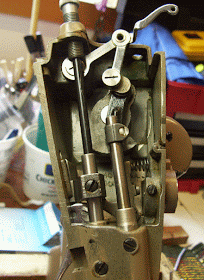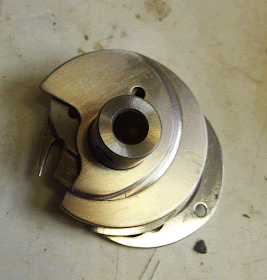This would be considered a peak and freak. Freak out at all the work.Close it up and say "I'm sorry, it just is not worth fixing. Maybe you should buy a new machine."
But new machines like 1951 vintage 301a Long Beds are not to be had, just like that. But there were a lot of them made and I am sure that there are many in much better shape than Sal.
God knows I am not trying to make a living from this avocation. I have HOURS and HOURS of labor in this clean up. No one can afford this machine now. Were I a professional, I would have shunned this project, most certainly. So I am glad I am not a professional. I feel quite proud of this accomplishment.
I also wonder what a professional would think, should he or she read this blog and learn of my stupidity. See this screw? I tried for thirty minutes to put a DIFFERENT screw in the hole that holds on the tension release lever. Thirty stupid minutes. Finally, I decided to try this screw. It worked in about 30 seconds. DUMB.
Or how about putting the looper on the hook backwards?
This is the way it came off the machine.
I put the clean parts back together, backwards, and wondered why the needle bent and pinged as it went through the cycle. I finally decided to check the photos I had taken. DUH. Once I turned it around, smooth as silk.
Will I remember for the next time? I don't know. I will, however, remember to keep the computer with the photos close at hand.
What would an OSMG do about this old motor? Probably do what I did, take the armature out and
clean the commutator and most likely replace the brushes.
I don't have new brushes so I checked them and cleaned the brush tubes. I put the motor was back together in fifteen minutes, this time. On Sunday it took me thirty. I wasted time by taking it ALL the way apart. Not necessary. Practice makes perfect; or close, anyway.
The electrical was a bit scary so I used another set up from a different machine to test it. I then decided that I wanted to re-wire it. I spent another 15 minutes trying to find its power cord and foot controller. Finally found it, in the last place I looked, in a drawer in a sewing machine cabinet in the shop. Geez. I have to write this stuff down.
It always amazes me that these old machines stitch after all that. The stitches are good. The tension needed tweaking, but NOT THE BOTTOM. I am just amazed.
Would I take on a project like this again? Hard to predict. Perhaps if it is a five dollar machine. I paid much more than that for Sal. I committed to the sale without looking at the machine. I am not sorry, not in the least. But I don't have to make a living doing this. And that, is a good thing.









I've REALLY enjoyed reading about Sal and seeing the amazing progress you have made. You may not want to do another but it has been wonderful to see Sal transform and I for one, would love to hear all about it if you do..thanks for fun reading!
ReplyDeleteWhy is he named Sal? You can can clean the brushes with alcohol, as you do with the tubes. Just make sure they are dry before you add the juice!!
ReplyDeleteDo you know why things are always in the last place you look? Because you stop looking after you find it.
Sal is a necessary obstacle. Next time you will cut 20-30 minutes off your routine based on your experience with him; saving the sewing machines of the world is a tough job, and who better to do it than you!!
He is named Sal after the seller.
DeleteI actually kept looking, to be sure that I really really did find it. And if you believe that I have a bridge I can sell you in Brooklyn.
YOU are better at this job than I am. But together we can save more.
Byooootiful job!!!
ReplyDelete- Rain
Wow! What a wonderful transformation. I'm glad we hobbyists exist, so that these old machines have a chance.
ReplyDeleteGreat work!
ReplyDeleteI also take photos of parts as I'm taking a machine apart. I use the playback if needed when putting it back together.
Another system I use is drawing and masking tape! Any screw that may be confused with another screw gets taken out, cleaned, and then taped to a piece of paper. On that paper I draw where the screw came from. Maybe I'm ocd but I think it saves me time in the long run.
I think I have the madness, I have just finished the black on my Frister and Rossman"D" and it is like a mirror! I am so chuffed, but if I had paid myself a wage I would have been on about £1 an hour! Three out of four of my german machines are now working, and I am agonising now over which ones I should sell on E bay or at an antique shop, should I hang onto the pretty crashed gear saxonia? Decisions, decisions!
ReplyDelete